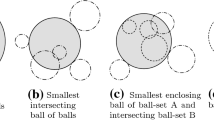Abstract
This manuscript presents a specialized primal simplex algorithm to obtain near optimal integer solutions for the singly constrained assignment problem. An optimal solution for the continuous relaxation of the problem is obtained by generalizing the alternating basis algorithm of Barr, Glover, and Klingman for the pure assignment problem. Near optimal integer solutions are obtained by pivoting into the optimal basis the slack variable associated with the side constraint. Our empirical analysis indicated that for our test problems the soft-ware implementation of this algorithm was six times faster than CPLEX and four times faster than NETSIDE (a specialized code for network problems with side constraints). The integer solutions obtained in our tests were typically within 2% of the optimum of the continuous relaxation.
Similar content being viewed by others
References
V. Aggarwal, “A Lagrangean-Relaxation Method for the Constrained Assignment Problem”, Computers and Operations Research, Vol. 12, pp. 97–106, 1985.
M. Balinski, “Signature Methods for the Assignment Problem”. Operations Research, Vol. 33, pp. 527–536, 1985.
M. Balinski, “A Competitive (Dual) Simplex Method for the Assignment Problem”, Mathematical Programming, Vol. 34, pp. 125–141, 1986.
M. Ball, U. Derigs, C. Hilbrand, and A. Metz, “Matching Problems with Generalized Upper Bound Side Constraints”, Networks, Vol. 20, pp. 703–721, 1990.
R. Barr, F. Glover, and D. Klingman, “The Alternating Basis Algorithm for the Assignment Problem”, Mathematical Programming, Vol. 13, pp. 1–13, 1977.
R. Barr, K. Farhangian, and J. Kennington, “Networks with Side Constraints: An LU Factorization Update”, The Annals of the Society of Logistics Engineers, Vol. 1, pp.66–85, 1986.
D. Bertsekas, “A New Algorithm for the Assignment Problem”, Mathematical Programming, Vol. 21, pp. 152–177, 1981.
D. Bertsekas, “The Auction Algorithm: A Distributed Relaxation Method for the Assignment Problem”, Annals of Operations Research, Vol. 4, pp. 105–123, 1988.
R. Bixby, “Implementing the Simplex Method: The Initial Basis”, ORSA Journal of Computing, Vol. 4, pp. 267–284, 1992.
J. Brans, M. Leclercq, and P. Hansen, “An Algorithm for Optimal Reloading of Pressurized Water Reactors”, Operational Research '72, Editor M. Ross, North Holland Publishing Company: Amsterdam, pp. 417–428, 1973.
N. Bryson, “Parametric Programming and Lagrangian Relaxation: The Case of the Network Problem with a Single Side-Constraint”, Computers and Operations Research, Vol. 18, pp. 129–140, 1991.
S. Gass and T. Saaty, “The Computational Algorithm for the Parametric Objective Function”, Naval Research Logistics Quarterly, Vol. 2, pp. 39–45, 1955.
F. Glover, D. Karney, D. Klingman, and R. Russell, “Solving Singly Constrained Transshipment Problems”, Transportation Science, Vol. 12, pp. 277–297, 1978.
A. Gupta and J. Sharma, “Tree Search Method for Optimal Core Management of Pressurized Water Reactors”, Computers and Operations Research Vol. 8, pp. 263–269, 1981.
R. Helgason and J. Kennington, “Network Flows”, Technical Report 92-CSE-26, Department of Computer Science and Engineering, Southern Methodist University, Dallas, TX 75275, 1992.
M. Hung and W. Rom, “Solving the Assignment Problem by Relaxation”, Operations Research Vol. 28, pp. 969–982, 1980.
R. Jonker and T. Volgenant, “A Shortest Augmenting Path Algorithm for Dense and Sparse Linear Assignment Problems”, Computing, Vol. 38 pp. 325–340, 1987.
J. Kennington and R. Helgason, Algorithms for Network Programming, John Wiley and Sons: New York, NY, 1980.
J. Kennington and Z. Wang, SEMI Users Guide, Technical Report 90-CSE-20, Department of Computer Science and Engineering, Southern Methodist University, Dallas, TX 75275, 1990.
J. Kennington and Z. Wang, “A Shortest Augmenting Path Algorithm for the Semi-Assignment Problem”, Operations Research, Vol. 40 pp. 178–187, 1992.
D. Klingman and R. Russell, “Solving Constrained Transportation Problems”, Operations Research, Vol. 23, pp. 91–106, 1975.
D. Klingman and R. Russell, “A Stream Lined Approach to the Singly Constrained Transportation Problem”, Naval Research Logistics Quarterly, Vol. 25, pp. 681–695, 1978.
H. Kuhn, “The Hungarian Method for the Assignment Problem”, Naval Research Logistics Quarterly, Vol. 2, pp. 83–97, 1955.
J. Mazzola and A. Neebe, “Resource Constrained Assignment Scheduling”, Operations Research, Vol. 34, pp. 560–572, 1986.
Author information
Authors and Affiliations
Rights and permissions
About this article
Cite this article
Kennington, J.L., Mohammadi, F. The singly constrained assignment problem: An AP basis algorithm. Comput Optim Applic 4, 347–374 (1995). https://doi.org/10.1007/BF01300862
Received:
Revised:
Issue Date:
DOI: https://doi.org/10.1007/BF01300862




